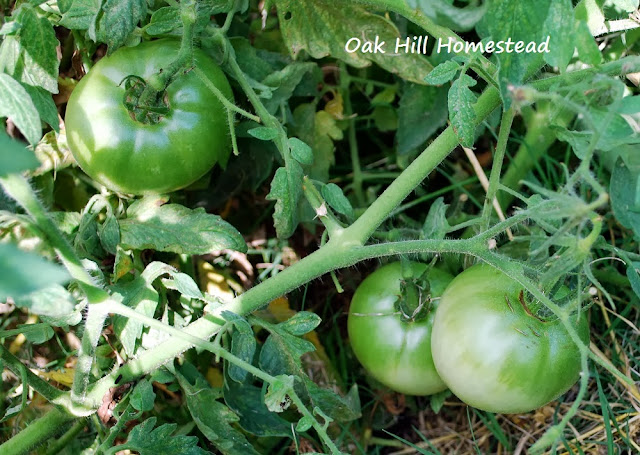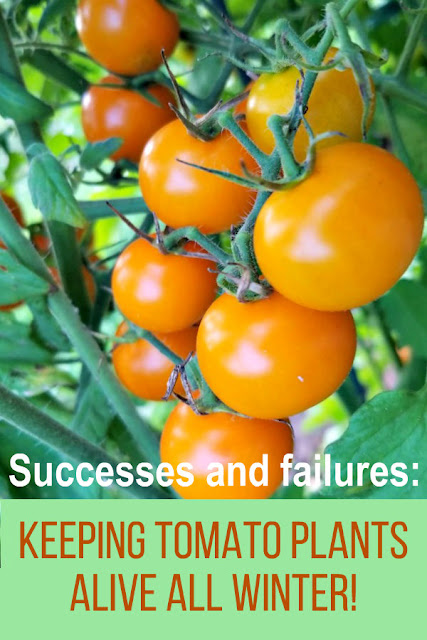Can you keep tomato plants alive all winter?
Several years ago I began taking cuttings from my tomato plants in the fall, before the first frost. I put the cuttings in jars of water and kept them alive on my kitchen windowsill so I could plant them in the garden in the spring.
You can find all the details in my post on over-wintering tomato plants without a greenhouse.
I kept records for several years on the successes and failures I experienced with my "perennial tomato clones." Did it work? Read on and find out!
This post was updated and rewritten in August 2020.
The First Year: Success!
The first year I took cuttings from both varieties of tomatoes in my garden: Bradley (an heirloom) and Early Girl (a hybrid).
If my experiment worked, hybrid varieties would produce fruit true to type because they are grown from the same plant instead of from seeds. (Hybrid seeds usually don't produce fruit like the parent plant; you never know what you'll get.)
The Early Girl cuttings grew roots like crazy. The Bradley plants grew some very long roots, but not as prolifically.
I lost the Bradley cuttings in January - I think they needed fertilizer or perhaps some comfrey tea or compost tea - but the Early Girl cuttings did very well. They grew tall and leggy - they needed more light, I'm sure.
I potted the Early Girl cuttings in February and planted them in the garden in spring, after all danger of frost had passed.

I watered them. I waited for that first red tomato, and waited, and waited. There were flowers, but no fruit.
I was afraid it was because I'd used cuttings but I knew that this experiment should be successful.
But I spoke to other local gardeners and to our county extension agent and found out that no one was getting tomatoes that summer - or many vegetables at all, really.
Was it all the rain we had during the summer? The grasshoppers? Lack of bees? Too hot, too humid? It was a mystery, and we'll probably never really know the cause. It was a strange summer.
The Second Year: Failure
This year my cuttings died before December arrived. I wasn't going to let this failure stop me though. I tried again that fall.
The Third Year: Success
In late October I cut a dozen branches from the still-thriving Arkansas Traveler plant growing in a tub in my front yard, and another half dozen from the Mortgage Lifter plants in the garden. Each cutting was about ten inches long.
If you know me, you know that I'm not partial to a particular variety of tomato - I'm willing to try them all! After all, gardening - like life - is a big experiment and a series of adventures.
I removed the leaves from the bottom of the cuttings and stuck them in glass jars, six to a jar. The cuttings lived on my kitchen windowsill over the winter. I potted them up in January and had nice big transplants in the spring.
I also grew other varieties from seed as usual, and I always end up buying a plant of a new variety at the garden center or feed store too. I just can't resist.
The over-wintered plants really give me a jump on the season though. These large, strong transplants are ready to go into the garden as early as the weather allows in spring.
The Fourth Year: Failure
The cuttings died early in the winter. The culprit: spider mites that were evidently on one of the herb plants already in my kitchen windowsill when I brought the tomato cuttings indoors.
I noticed the webs on the leaves of the tomato cuttings as they began dying, but it was too late.
Lesson learned: check the herbs and other potted plants before bringing in tomato cuttings, and check the tomato plants too! A hard shower from the hose will help dislodge insects.
The Fifth Year: Success
I took cuttings early in fall, so that if I had problems (cuttings dying early, for instance), I'd have time to cut more before frost killed the tomato plants in my garden.
I cut suckers from one of the Cherokee purple plants, the Juliet plants (a hybrid), and from my one and only Arkansas Traveler plant.
The Oklahoma weather was crazy that summer. As of October first I'd had exactly three red tomatoes and two handfuls of yellow pear tomatoes. Even the canning entries at our county fair were low that year because no one had a garden bounty of anything.
In the past, I've left the cuttings in water for most of the winter, planting them when the roots were so long and thick that I had no choice. This year I planted them in soil as soon as they had roots, using plastic cups from the grocery store with holes punched in the bottom with a knife, and filled with potting soil.
The cuttings survived the winter and grew well in the garden. There is less worry about the roots adapting to a new environment when you transplant them into pots right away, so I plan to continue doing that.
In conclusion
So yes, my experiment was successful in the long run - more than 50% successful over the years.
It would have been a better experiment if I'd attempted to over-winter the same varieties each winter, but weather is fickle and sometimes my best performing varieties the year before failed utterly the following year.
And while not every year was successful, I proved that it can be done, that you can over-winter your tomato plants by taking cuttings, rooting them, and nurturing them on a sunny windowsill until spring arrives once again.
I recommend starting tomatoes from seed in the spring too though, because I always like to have a Plan B. A summer without fresh tomatoes is unacceptable, in my opinion!
These big, healthy plants that successfully over-winter are easy to harden off and plant in the garden after all danger of frost has passed. (You can find out the approximate date of your last frost - and your average first frost in autumn too - by entering your zip code in this frost calculator from Dave's Garden.)
Will you try keeping your tomato plants alive all winter?
For more gardening and simple-living posts, subscribe to The Acorn, Oak Hill Homestead's weekly-ish newsletter, and join me on Facebook, Instagram and Pinterest. I'd love to see you there!
Related Post:
How to Root Tomato Cuttings

















